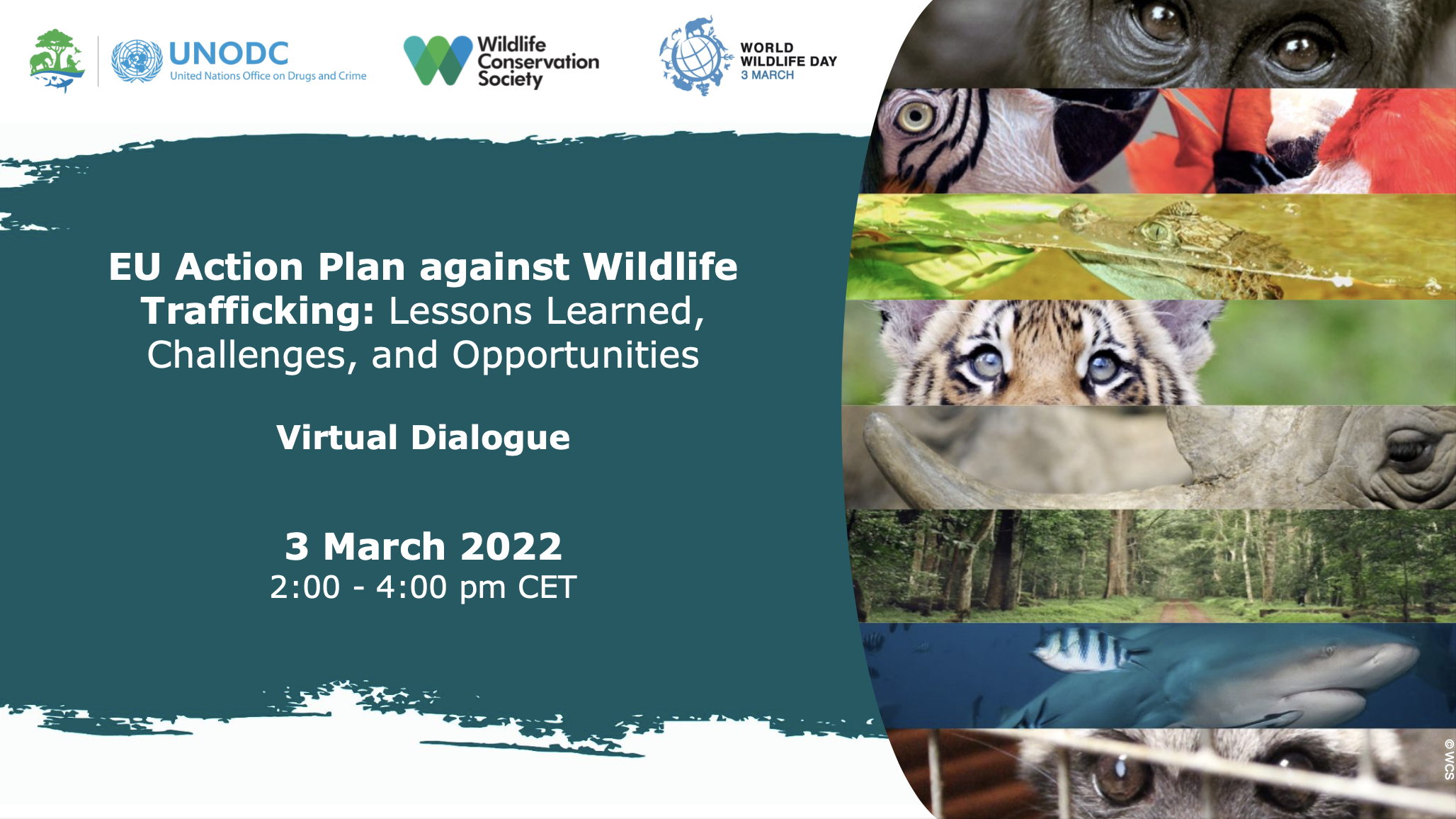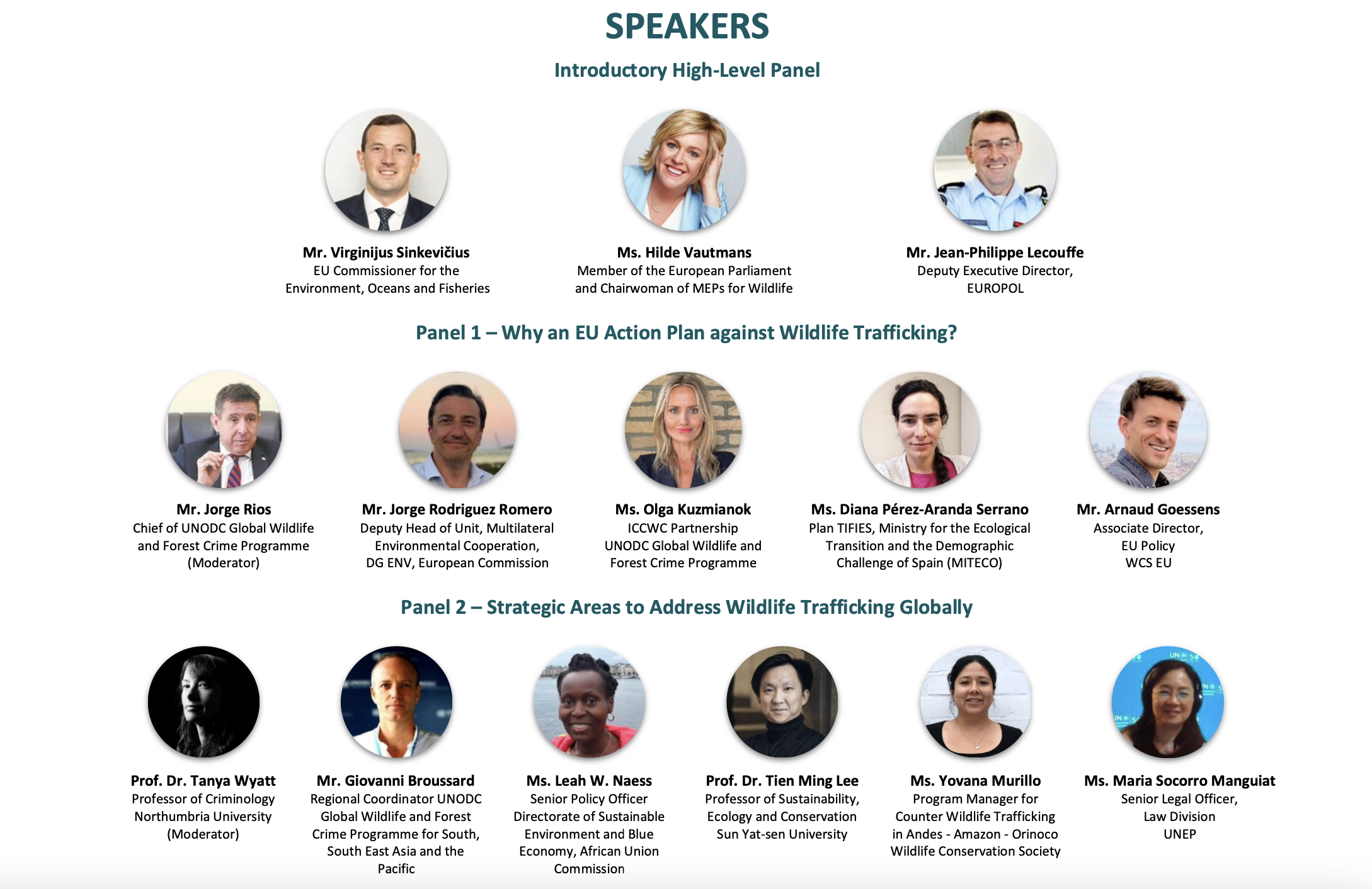
EU Action Plan against Wildlife Trafficking: Lessons Learned, Challenges, and Opportunities
On the occasion of World Wildlife Day, the United Nations Office on Drugs and Crime (UNODC) and the Wildlife Conservation Society (WCS) organised a virtual dialogue on 3rd March 2022 to present lessons learned and discuss challenges and opportunities for a renewed EU Action Plan to tackle wildlife trafficking, including how the EU can support the fight against wildlife trafficking in the field in partner countries.

Wildlife trafficking has become one of the most lucrative criminal activities and constitutes one of the most immediate threats to biodiversity in many parts of the world. Around the globe, wildlife is being bought and sold on an increasingly massive scale as pets, food, medicine, furs, feathers, skins, decorations, and trinkets. The European Union has an important role to play in addressing wildlife trafficking, as it constitutes a significant destination market, a hub for trafficking in transit to other parts of the world, as well as the source region for illegal trade in some species.
In addition to harming wildlife species, wildlife trafficking undermines local livelihoods and weakens impoverished rural economies further. As highlighted by the ground-breaking 2019 DG International Partnerships’ study on the interaction between security and wildlife conservation in sub-Saharan Africa, wildlife trafficking weakens the rule of law, exacerbates corruption, triggers conflicts, funds organised crime syndicates, and in some cases contributes to migration flows.
In February 2016, the European Commission adopted an EU Action Plan to tackle wildlife trafficking within the EU and to strengthen the EU's role in the global fight against these illegal activities, which is currently under review. It is timely to discuss what has been achieved to date and what the EU can still do further, particularly as a contribution to a new EU Action Plan.
This virtual dialogue brought together actors from Africa, Asia, Latin America, and the EU, from governments, IGOs, civil society, and academia sharing local, national, and international-level experiences.
The video recording is accessible here and a conference report is available here.

Final programme
Keynote Address
Mr. Virginijus Sinkevičius – EU Commissioner for the Environment, Oceans and Fisheries
Ms. Hilde Vautmans – Member of the European Parliament and Chairwoman of MEPs for Wildlife
Mr. Jean-Philippe Lecouffe – Deputy Executive Director, EUROPOL
PANEL 1 - Why an EU Action Plan against Wildlife Trafficking?
Moderator: Mr. Jorge Rios – Chief of UNODC Global Wildlife and Forest Crime Programme
Mr. Jorge Rodriguez Romero – Deputy Head of Unit, Multilateral Environmental Cooperation at DG ENV
Ms. Olga Kuzmianok – ICCWC Partnership, UNODC Global Wildlife and Forest Crime Programme
Ms. Diana Pérez-Aranda Serrano – Plan TIFIES, Ministry for the Ecological Transition and the Demographic Challenge of Spain
Mr. Arnaud Goessens – Associate Director, EU Policy, WCS EU
PANEL 2 - Strategic Areas to Address Wildlife Trafficking Globally
Moderator: Prof. Dr. Tanya Wyatt – Professor of Criminology, Northumbria University
Mr. Giovanni Broussard – Regional Coordinator, UNODC Global Wildlife and Forest Crime Programme in Southeast Asia
Ms. Leah W. Naess – Senior Policy Officer, Directorate of Sustainable Environment and Blue Economy, African Union Commission
Ms. Yovana Murillo – Program Manager for Counter Wildlife Trafficking in Andes - Amazon - Orinoco, WCS
Prof. Dr. Tien Ming Lee – Oxford Martin Visiting Fellow, and Schools of Life Sciences and Ecology, Sun Yat-sen University
Ms. Maria Socorro Manguiat – Senior Legal Officer, Law Division, UN Environment Programme